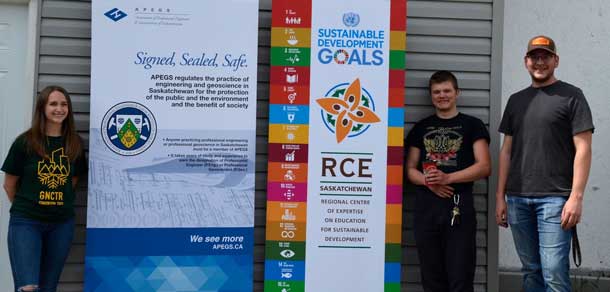Those involved:
Star Blanket Cree Nation, APEGS, the University of Regina Faculty of Engineering and Applied Science, MacPherson Engineering, ASHRAE, Anaquod Plumbing and Heating, Uponor, Fries Tallman and Saskatchewan’s United Nations Regional Centre of Expertise on Education for Sustainable Development.
The Achievement:
More than 60 per cent of the homes on Star Blanket First Nation have air quality issues due to black mold. The basements in these homes are uncomfortably cool because of inadequate HVAC systems.
This sparked a collaboration in 2017 with Wendell Star Blanket, a member of Star Blanket Cree Nation, and MacPherson Engineering and Uponor, which holds several patents for a hybrid passive heating technology.
The following year, a hybrid passive heating system installed in Wendell’s basement by MacPherson Engineering and Uponor resulted in improved air quality, increased comfort and a more cost-effective solution to heat the space.
The next step was to conduct a study to measure the capacity of passive heating as a sustainable and economically viable solution to improve health, safety and comfort.
In autumn of 2018, four senior undergraduate students from the University of Regina’s Faculty of Engineering and Applied Science collected data, which included temperature comparisons, humidity levels, electricity usage and natural gas usage for two homes in the Star Blanket community – one with the installed passive heating system and one without.
Radiant heating saved $900 in electricity costs.
It was found that the basement with the radiant heating system was slightly warmer than the basement without. Also, the basement with radiant heating had surface humidity as high as 41 per cent, while the home without was as high as 55 per cent. This showed that the basement with radiant heating is less likely to develop mold.
Through analysis of natural gas usage, it was determined the installation of the radiant heating system did not increase natural gas consumption. It was also shown that by removing the space heaters and installing the radiant heating system, approximately $890 was saved per year in electricity costs.
In 2019, a second hybrid passive heating system was successfully installed by the University of Regina student-team, MacPherson Engineering, Uponor and Anaquod Plumbing and Heating.
After completing a review of the first installation, the project team was able to reduce capital costs by approximately 30 per cent. Design of the system was completed by the University of Regina student-team, with mechanical engineers at MacPherson Engineering providing guidance.
In an effort to use this project as a development opportunity for those considering the trades or the applied sciences, representatives from MacPherson Engineering and the University of Regina hosted an engineering workshop at Payepot School. Students from the school were invited to participate in the installation of the systems.
The radiant heating system did not increase
natural gas consumption.
Mechanical engineers at MacPherson Engineering served as industry advisors and assisted the U of R undergraduate student team over the duration of the project. MacPherson Engineering also partnered with the U of R to instruct a senior-level course focused on the design of heating, ventilating and air-conditioning systems.v
Monetary costs associated with this project have been generously sponsored by APEGS, MacPherson Engineering, Uponor and Fries Tallman.v
Star Blanket Cree Nation covers much of southern Saskatchewan. There are 709 members of the Nation, with 354 currently living on-reserve in 82 homes.
The teams:
Mechanical engineers at MacPherson Engineering served as industry advisors and assisted the University of Regina undergraduate student team over the duration of the project. MacPherson Engineering also partnered with the University to instruct a senior-level course focused on the design of heating, ventilating and air-conditioning systems. This course further complemented the technical capacity of the student team.


